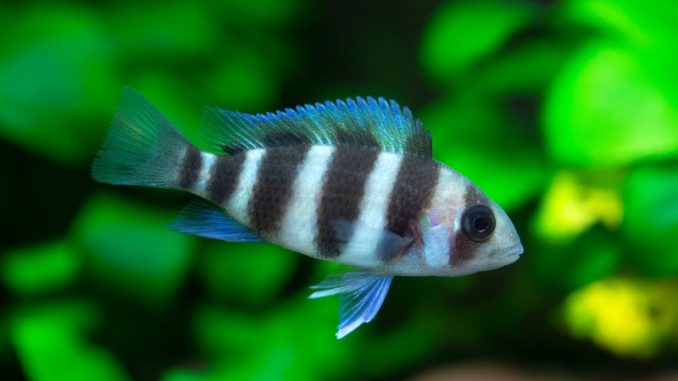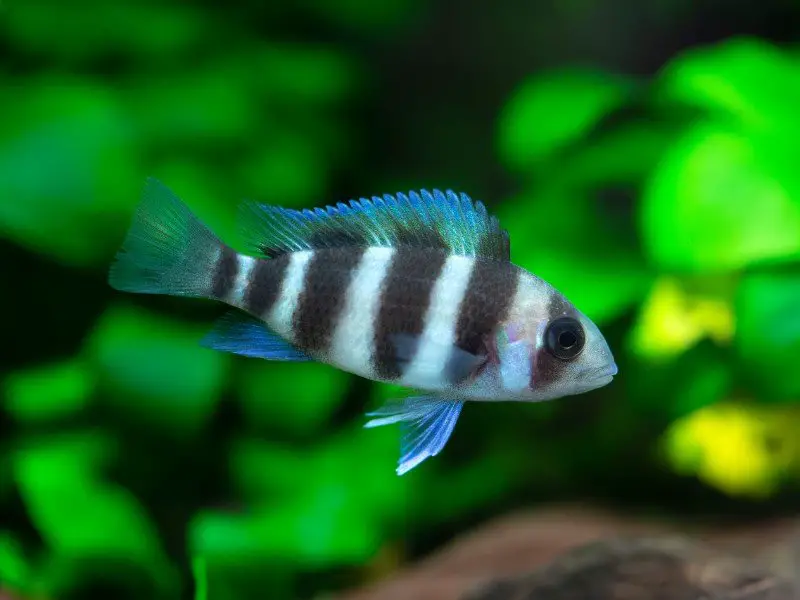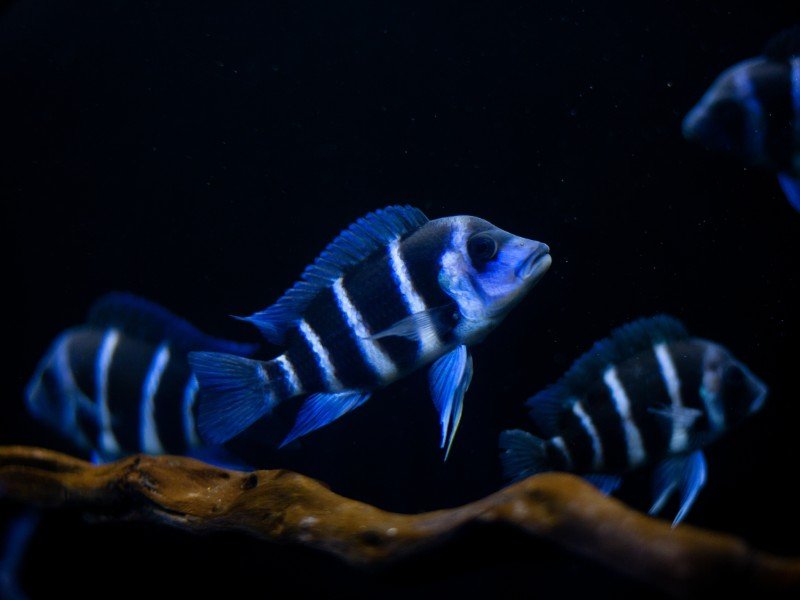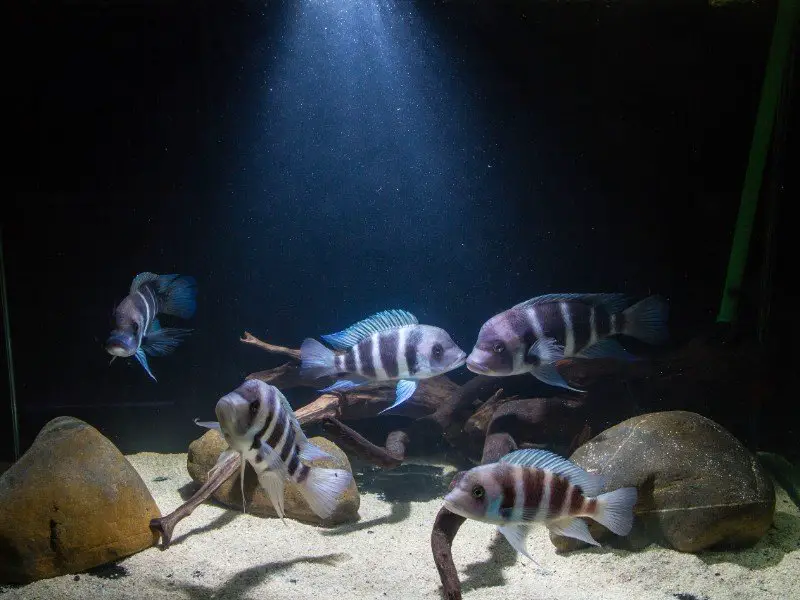
The frontosa cichlid is a freshwater fish of the Cichlidae family. There are several different color variants of frontosa cichlids, including zaire blue frontosas, Kavala frontosas, and Tanzanian six-stripe frontosas.
Frontosa cichlids have bold coloring, with five to seven dark bands on a pale or dark blue body. These African cichlid fish are semi-aggressive and have instinctive territorial behaviors. Frontosas are popular with aquarists due to the fish’s ease of care and beautiful colors, despite the fish’s occasional behavioral issues.
TABLE OF CONTENTS
- Frontosa Cichlid Facts & Overview
- Appearance & Behavior
- Frontosa Cichlid Tank Requirements
- Common Frontosa Cichlid Health Issues and Diseases
- Frontosa Cichlid Tank Mates
- Frontosa Cichlid Diet and Feeding
- Breeding the Frontosa Cichlid
- Should You Get a Frontosa Cichlid for Your Aquarium?
- Frontosa Cichlid FAQs
Frontosa Cichlid Facts & Overview

| Scientific name | Cyphotilapia frontosa |
| Common names | Frontosa cichlid, humphead cichlid, frontosa |
| Distribution | East Africa |
| Size | 12–14 inches |
| Life expectancy | 15–25 years |
| Color | Shades of blue, gray, or white, with several vertical black stripes |
| Diet | Carnivore |
| Temperament | Semi-aggressive |
| Minimum tank size | 70 gallons |
| Temperature | 74–80°F (24–26°C) |
| pH | 8.0–9.0 |
| Hardness | 12–14 dGH |
| Care level | Moderate |
| Breeding | Mouthbrooder |
Origin
The frontosa cichlid is commonly found in several large lakes in East Africa, including the world’s second-longest freshwater lake: Lake Tanganyika. The fish spends most of its time in the lake’s depths, surfacing only to find food.
The natural habitat of the frontosa cichlid is dark, at great depth, and rocky with minimal vegetation. Lake Tanganyika is one of the richest freshwater ecosystems in the world, and frontosa cichlids share their home there with up to 2,000 other species of fish.
Adult Size & Lifespan
Full-grown frontosa cichlids are large fish, reaching up to 14 inches long in the wild and in captivity. Males are about 2 inches longer than females.
The average lifespan of the frontosa cichlid is 15 years. With the right care, some fish in captivity live for up to 25 years.
Availability
Frontosa cichlids are easy to breed in captivity, so they’re widely available online and in local pet stores. The typical cost of a frontosa cichlid is $17–$28, depending on the uniqueness of the fish’s appearance. Some rare frontosa cichlids, like black widow frontosa cichlids, sell for around $50 per fish.
Reputable online stores selling frontosa cichlids are:
Appearance & Behavior
The frontosa cichlid is a large cichlid species with a blue-toned body marked by black vertical bands. The fish is active, semi-aggressive, and known to fight other fish over food and territories.
Colors, Patterns, Fins, and Sex Differences
Frontosa cichlids are found in vibrant shades of pale blue, dark blue, gray, and white, with black markings or vertical black bands on their bodies.
Isolated colonies of frontosa cichlids in Lake Tanganyika have produced several frontosa color varieties, including:
- Burundi six-stripe
- Kavala
- Tanzanian six-stripe
- Tanzanian seven stripe
- Samazi
- Kipili
- Zaire blue
- Zambian blue
- Black widow
Some color variants of frontosa cichlids are darker than others, and they can have varying numbers of stripes. Black widow frontosa cichlids are the rarest color variant — they’re white with black spots and blue-tinged fins and have larger bodies than most frontosa cichlids.
Male and female frontosa cichlids look similar, but, at sexual maturity, males develop a prominent nuchal hump and have longer fins than females. When stressed due to disease or poor water conditions, frontosa cichlids become duller in color than normal.
Frontosa cichlids have a similar body shape to flowerhorn cichlids, but flowerhorns have bigger nuchal humps than frontosa cichlids, different colors, and no stripes.
Typical Behavior
The frontosa cichlid is a semi-aggressive fish species that doesn’t get along well with other fish. Although frontosas are less aggressive than most other cichlid species, they’re territorial and are known to flare their gills and chase fish if they’re trying to claim space or food.
Frontosa cichlids are bold, outgoing, and tamable, often learning to eat out of the fishkeeper’s hand. The fish are slow, clumsy swimmers that don’t like to waste energy, and they spend most of their time drifting in groups around the lower waters of the tank.
Although these fish aren’t nocturnal, they prefer dim environments and are most active when the tank’s lights are off.
Frontosa Cichlid Tank Requirements

Caring for frontosa cichlids is easy. The fish are hardy and sociable, but they require plenty of swimming space and stable water conditions.
Habitat and Tank Setup
Frontosa cichlids live in the rocky depths of large freshwater lakes in Africa. Mimic the fish’s natural habitat to ensure the fish is healthy and comfortable in captivity.
Choose a substrate that replicates the sandy bed in Lake Tanganyika. Aragonite sand or crushed coral are good substrates to maintain the water’s alkaline pH.
Add rocks and caves to the tank to replicate the fish’s rocky habitat. Frontosa cichlids enjoy redecorating their tanks, so ensure all decorations are weighed down to prevent them from being dug up by the fish.
Plants aren’t required in a frontosa cichlid tank, but if you choose to include plants, the most suitable plants are those that can be attached to driftwood, such as java moss, java fern, and anubias, so that the fish don’t dig them up.
Tank Conditions
Ideal tank conditions for a frontosa cichlid are:
| Water type | Neutral, slow-moving freshwater |
| Tank size | Minimum of 50 gallons for one juvenile, 75 gallons for one adult, and at least 125 gallons for a group of three or more adult fish |
| Water temperature | 72–82°F |
| Substrate | Aragonite sand or crushed coral |
| Tank setup | Rocks and caves |
| Acidity | 8.0–9.0 pH |
| Water hardness | 12–14 dGH |
| Filter | Yes, to keep the water clean |
| Bubbler | Yes, to ensure highly oxygenated water, which the fish are used to in the wild |
| Lighting | Dim aquarium lighting on a timer |
| Water heater | Yes, to keep the water warm |
The frontosa cichlid’s natural habitat has stable water conditions, and the fish isn’t accustomed to changes of temperature, pH, or alkalinity. Ensure your aquarium’s water is clean and stable before introducing the fish to the tank.
Common Frontosa Cichlid Health Issues and Diseases

Several common cichlid diseases affect frontosa cichlids. Most diseases can be treated and cured by quarantining the affected fish and using commercial medications or water treatments.
| Health Issue | Symptoms | Suggested Action |
|---|---|---|
| Swim bladder disease | Sinking to the bottom or floating to the top of the tank, distended belly, curved back, reduced appetite | Don’t feed the fish for three days, add 1/8 teaspoon of Epsom salt per 5 gallons of water, and speak to your veterinarian about antibiotics |
| Malawi bloat | Abdominal swelling, loss of appetite, rapid breathing, discolored feces | Perform a large water change and add metronidazole (an antibiotic) to the water according to the packet’s instructions |
| Cotton wool disease | Fuzzy white growth on the body, head, and fins | Isolate affected fish in a hospital tank and add aquarium salt or antibiotics to the water in the hospital tank following advice from your veterinarian |
| ICH | White, salt-like sprinkles on the fish’s scales, flashing (rubbing against rough surfaces), lethargy, loss of appetite | Increase the tank’s temperature by 2 or 3 degrees, add aquarium salt or potassium permanganate to the water |
Frontosa Cichlid Tank Mates
The best frontosa cichlid tank mates are large, hardy, confident fish species from Lake Tanganyika, which can tolerate the same hard, alkaline waters as frontosas. Don’t house frontosa cichlids with invertebrates, fast-moving fish that are small enough to fit into a frontosa’s mouth, or fish with different water requirements.
Great tank mates for frontosa cichlids include:
- Other frontosa cichlids (the fish are calm and active in schools of 8–12)
- Plecos
- Bichirs
- Cuckoo catfish
- Rainbowfish
Frontosa Cichlid Diet and Feeding
In the wild, frontosa cichlids are carnivorous ambush predators that eat herring or sardine cichlids. The fish drift under their prey at dawn and dusk, then snatch their food without expending much energy.
Most frontosa cichlids are also lazy eaters in captivity, and will only eat sinking food that falls near their mouths. The best foods for this species are krill, prawns, mysis shrimp, earthworms, mussels, and small fish that sink slowly to the bottom of the aquarium. Supplement the fish’s diet with sinking pellets made for cichlids and an occasional piece of blanched spinach or kale.
Feed your fish a pinch of food three times per day, for six days a week, taking one day off to prevent bloat and constipation. Don’t feed bloodworms to frontosa cichlids because they can cause the fish’s bowel to inflate.
Breeding the Frontosa Cichlid
Breeding frontosa cichlids is easy, and the fish don’t require a dedicated breeding setup. Frontosa cichlids become sexually mature when they’re three years old.
To breed frontosa cichlids, follow these steps:
- Prepare a group of frontosa cichlids for breeding by feeding them high-quality, high-protein, live food. Whole proteins trigger the production of eggs and sperm. Ensure there is at least one healthy male in the tank
- Wait for the fish to breed. The male’s nuchal hump will become darker, attracting a female. The pair will clean a space to breed in and the male will release milt, triggering the female to lay an egg
- Allow the process to continue until the female has laid all her eggs. Frontosa cichlids are mouth brooders, so the female will collect and carry all her eggs (between 20 and 50) in her mouth
- Wait for five to seven weeks for the female to incubate her eggs. During this time, the female won’t eat. Once the eggs hatch, the female releases them so she can eat
- Feed the fry a diet of baby brine shrimp or powdered flake foods. For the first 40 to 50 days, the fry will swim close to the female or swim back into her mouth if they sense danger
- Move the fry into their own tanks once this time has passed and the fry are large enough to be independent
Should You Get a Frontosa Cichlid for Your Aquarium?
Frontosa cichlids are colorful, interesting, freshwater fish that are fun to watch. However, the fish aren’t suitable for all community tanks.
Consider getting a frontosa cichlid if your freshwater aquarium contains compatible fish and you have enough room for a school of frontosas, or if you plan to establish a single-species aquarium. Don’t get a frontosa cichlid if your existing tank’s water conditions can’t be adapted to suit this species, or if your tank contains small fish that may be eaten by the frontosa cichlid.
Despite their semi-aggressive personalities, frontosa cichlids are confident fish that provide a fantastic source of entertainment in a home aquarium.
Frontosa Cichlid FAQs
How Big Does a Frontosa Cichlid Get?
Male frontosa cichlids grow as big as 14 inches long, while females grow to about 12 inches long. These fish are slow growers, reaching sexual maturity at two or three years old. You’ll need plenty of tank space for these fish — at least 75 gallons for a single fish, or 125 gallons for a group of three or more fish.
Is a Frontosa Easy to Keep?
Yes, a frontosa cichlid is easy to keep as long as you maintain clean, stable water conditions and house the fish with suitable tank mates. Frontosa cichlids are hardy and mild-mannered, but they’re susceptible to common fish diseases and are known to eat small fish. Make sure to properly maintain the aquarium and choose large, slow-swimming tank mates to prevent disease and conflict in the tank.
How Much Does a Frontosa Cichlid Cost?
The average cost of a frontosa cichlid is $17–$28, depending on how rare or unique the fish is. Some rare color variations of frontosa cichlids, like black widow frontosas, cost about $50 per fish. Frontosa cichlids should be housed in groups of five or more, so prepare to pay for at least five fish at once.
What Fish Can You Put With Frontosas?
The best fish to put with frontosas are large, confident fish from East Africa, like plecos, bichirs, and cuckoo catfish. Don’t put small, fast-swimming fish with frontosa cichlids — your frontosas will view them as prey. Before you consider adding different fish species to a frontosa tank, make sure you have at least five frontosa cichlids in your tank to replicate their natural schooling behavior in the wild.
Can Frontosas Live With Plants?
Yes, frontosas can live with plants. However, these cichlids are known to dig in the substrate, so they’ll likely uproot plants and disarrange the tank. The best plants to add to a frontosa cichlid tank are those that the fish can’t dig up. Java moss, java fern, and anubias are all good choices because they can be attached to driftwood.

Be the first to comment